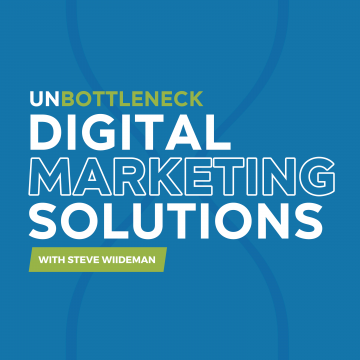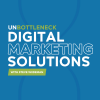Podcast: Play in new window | Download
In this episode of the Unbottleneck Podcast, Steve Wiideman is joined by digital compliance expert, Lea Scudamore, to discuss Web Content Accessibility Guidelines (WCAG) and creating websites that align with requirements for the disabled, and why it matters for your brand.
About Our Guest: Lea Scudamore
Lea Scudamore is an SEO at Aimclear, a digital marketing agency, and focuses on search engine optimization, user experience, and organic content strategies, including website design, and content development. Lea leads the team in Web Content Accessibility Guidelines (WCAG) and Americans with Disabilities Act (ADA) website compliance for clients.
Sponsored by Ryte
Featured in this episode:
- What Is Web Accessibility?
- Do All Websites Need to Comply with Accessibility?
- Testing Your Site for Accessibility
- Key Focal Points for Accessibility
Did you know that only 10% of the world’s websites are close to being accessible to all users? This means that 90% of websites are ignoring an important part of the user experience which can negatively impact conversion (aka money).
So if accessibility is such an important part of the user experience, why do business owners ignore it? There are many reasons this could be, such as cost and not understanding the market, but this is something that can no longer be ignored.
What is Web Accessibility?
In a nutshell, web accessibility is about ensuring that your website shows up to the widest range of people as possible, including the disabled. Some examples of web accessibility include:
- Using alt text on images – these are short descriptions of images (ex: “Blue shirt with daisies”)
- Adding captions to videos
- Adjusting front from 8pt to 10pt
- Using contrasting colors between the background and text colors
The reality is, 22% of the market has a disability – that’s one in five people! If your website is not accommodating those users, they will find another website that is.
Business owners should look at accessibility as a way to get more customers and drive more business. By implementing accessible elements to your website, you will not only create a better user experience, but you can increase:
- Conversion rates
- Search engine rankings
- Overall traffic
Do All Websites Need to Be Accessible?
Simply put, yes! One of the biggest misconceptions is that accessibility is limited to the blind and hearing impaired. Accessibility is about addressing all of the disabilities you can’t see, such as cognitive disorders.
Another misconception is thinking that the disabled are “not my customers.” People don’t just surf the internet for themselves – they are buying things for their loved ones, registering their children for activities, etc. If you have a closed mindset about web accessibility, then it’s going to be difficult to grow your business.
Pro-Tip: “Word of mouth” is more powerful than any marketing strategy. There are online communities that cater specifically to website accessibility. So whether your website is providing a positive or negative experience, they’re going to share it.
Test Web Accessibility, Don’t Guess
There are many helpful tools available at our fingertips to test how accessible a website is. Many tools will identify technical or design errors, and warnings and tips to improve your website’s accessibility. Some popular tools for testing include:
- Google Core Web Vitals
- Webaim.org (available in Chrome or Firefox extensions)
- W3.org
However, it is not just enough to run a test or follow a simple checklist. A great way to win at accessibility is by going straight to the source – your customers! Whenever you want to get an idea of how your website is performing, you should make it a regular practice to have people with different disabilities test it out.
Focus on the User Experience
Don’t just assume that because you followed a checklist, everything is going to work smoothly for those people. Have them use your website in different ways and give you feedback about what’s working and what’s not. This is the only way to really understand how your website is helping or hurting your user experience.
Pro-Tip: Having real users test your website and give feedback is a great strategy for small businesses who may not be able to afford an agency to come in and do the work for them. Example: “Hey, can I give you a gift card to our website just to test the user experience and give me some suggestions?”
Key Focal Points of Accessibility
If people have to think about where to navigate on your website, it has already failed. Think about it like this, let’s say 80% of people that go to your website get frustrated due to accessibility issues. Are those 80% going to come back? Absolutely not!
Here are some key focal points of accessibility to be aware of as you audit your website and begin making improvements:
- Avoid small text; Make sure fonts are large
- Avoid having clickable elements too close together
- Don’t make content wider than the screen
- Ensure that the font color is not being washed out by the background color (ex. Avoid putting green on red)
- Test the zoom and pinch features to make sure people can still see the content
- Test vertical and horizontal display on mobile devices
- Keep your logo on the top left of the screen
While you want your website to be visually appealing, you don’t want to neglect the accessibility aspect. Therefore, you need to create balance. You can still be creative and maintain usability standards so that users know what to do when they get to your website.
Can Websites Be 100% Compliant?
The truth is, websites are never going to be 100% compliant, but the goal is to get as close to 100% as possible. Websites are constantly changing and evolving. The work is never done. There’s always going to be one new product or service, so consider this an essential ongoing task that comes with owning a website.
Making Your Site Work for Everyone
When you do a good job at making your website, app, online documentation, PDF or internal system accessible, you’re making the world better for people with and without disabilities. Who doesn’t enjoy surfing the internet with ease?
Creating a more pleasant experience for all users means quicker checkouts and purchases because less time is spent trying to figure out how to do something!
As you approach web accessibility, ask yourself “how do I make this work for EVERYBODY?”
For more information about web accessibility, and to review your website’s accessibility, be sure to check out Aimclear’s Blog.
Keep up with the web accessibility essentials and digital marketing strategies. Follow Steve on LinkedIn!




